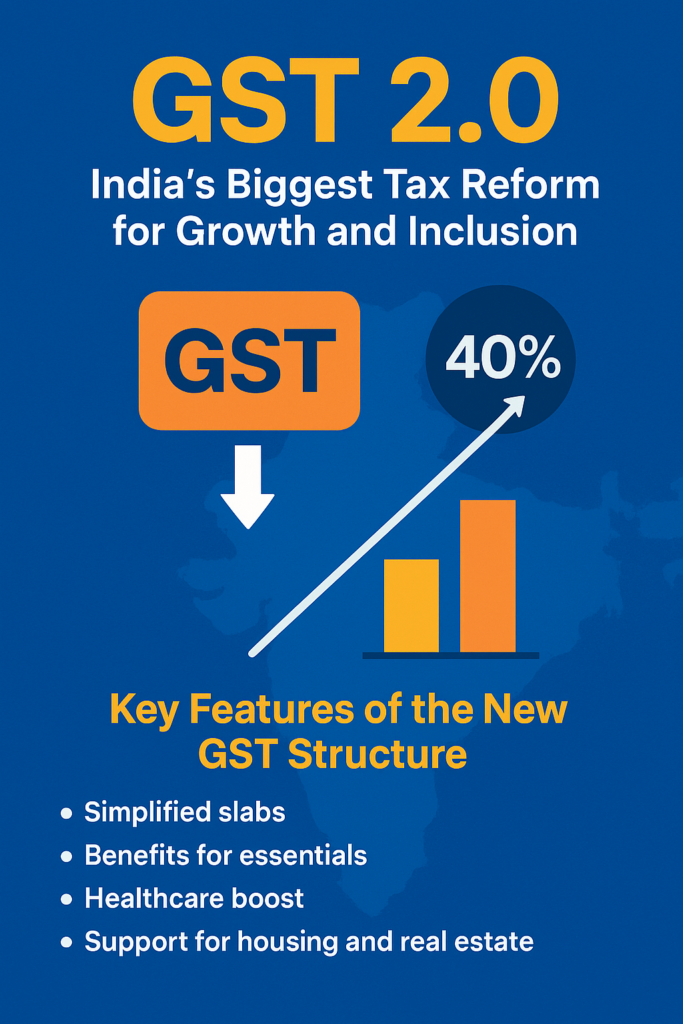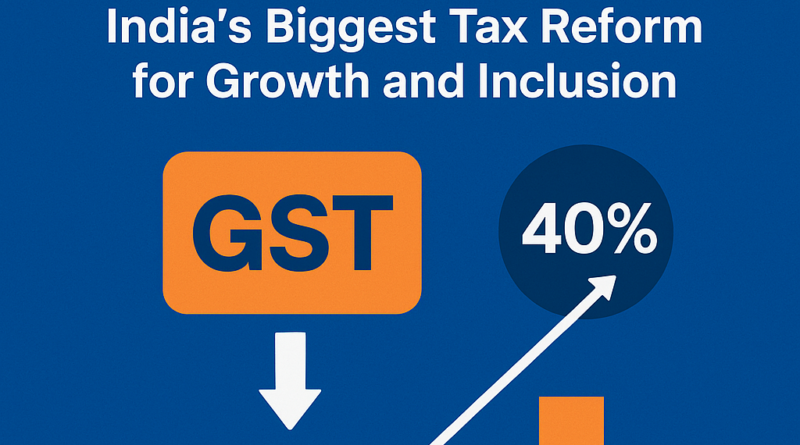GST 2.0: India’s Biggest Tax Reform for Growth and Inclusion
The Goods and Services Tax (GST) Council, in its meeting on 3rd September 2025, approved a historic rationalisation of GST rates, which will roll out from 22nd September 2025. Supported unanimously by all states, the reform marks a significant step toward simplifying India’s indirect tax system while easing the burden on the common man.
Since its introduction on 1st July 2017, GST has replaced a complex web of central and state taxes. Earlier, goods and services were divided across four major slabs — 5%, 12%, 18%, and 28%. Now, India has moved to a streamlined two-tier structure with just 5% and 18%, while luxury and sin goods will attract a 40% tax.
Prime Minister Narendra Modi hailed the reform as a “double boost for support and growth”, emphasizing that the new GST structure will simplify compliance, ease the burden on essentials, and accelerate economic growth.
Key Features of the New GST Structure
- Simplified Slabs
- 12% and 28% slabs abolished.
- Two main slabs: 5% (essentials, daily-use goods) and 18% (standard goods and services).
- 40% tax introduced on luxury and sin goods such as high-end cars, cigarettes, and alcohol.
- Benefits for Essentials
- Essentials like milk, eggs, and education services remain tax-free.
- LPG, tea, and medicines at 5%.
- Rationalisation reduces the cost of FMCG and consumer durables.
- Healthcare Boost
- Essential medicines and devices see reduced GST.
- Critical health services remain exempt.
- Higher taxes on harmful products discourage unhealthy consumption.
- Support for Housing and Real Estate
- Lower GST on construction materials cuts project costs.
- Encourages affordable housing under the “Housing for All” vision.
- Improves investor confidence in the real estate sector.
- Automobile Sector Relief
- Reduced GST lowers vehicle costs.
- Stimulates demand, especially in two-wheelers and entry-level cars.
- Creates jobs and boosts supply chains.

Challenges in Implementation
While the reforms promise long-term benefits, the transition comes with hurdles:
- Compliance Pressure: MSMEs face challenges in adapting to new systems and compliance costs.
- Revenue Concerns: States and the Centre worry about balancing collections with reduced rates.
- Consumer Confusion: Frequent rate changes risk creating uncertainty.
- Inflation Risks: Margins may shrink, pushing some businesses to raise prices.
- Sectoral Impact: Import-heavy and input tax credit–reliant industries could face financial strain.
If not managed carefully, reduced margins and compliance challenges may lead to reduced competition, consolidation of industries, and inflationary pressures.
The Road Ahead: GST 2.0 and India’s Future
Despite challenges, GST 2.0 is positioned as a transformative reform that aligns with India’s vision of becoming a $5 trillion economy.
- Boost to Domestic Industries: Rationalised duty structures support MSMEs and improve global competitiveness.
- Healthcare for All: Lower costs for medicines and services complement schemes like Ayushman Bharat.
- Support for Startups: Simplified compliance, digital tools (UPI, Aadhaar, GSTN, e-invoicing), and schemes like Startup India empower entrepreneurs.
- Renewable Energy Growth: Tax relief encourages investment in sustainable energy.
- Strengthening the Middle Class: Tax relaxation for households up to ₹12 lakh improves disposable income, boosting savings and consumption.
- Digital-First Compliance: AI-driven tax tools, GST helpdesks, and e-invoicing simplify filing and improve transparency.
By reducing costs, encouraging investment, and supporting innovation, GST 2.0 strengthens the backbone of India’s economy — the middle class, MSMEs, and labour-intensive industries.
Conclusion
The GST rationalisation of 2025 represents more than just a tax reform — it is a nation-building initiative. It reduces the tax burden on essentials, boosts affordability in housing and healthcare, and stimulates demand in key sectors like automobiles and real estate. At the same time, it aligns taxation with India’s long-term goals of Viksit Bharat by driving inclusive growth, job creation, and sustainable development.
If implemented effectively with safeguards, GST 2.0 has the potential to transform India’s economy, empower citizens, and cement the country’s position as a rising global economic powerhouse.
For more such interesting blogs, please visit: https://vichaardhara.co.in


